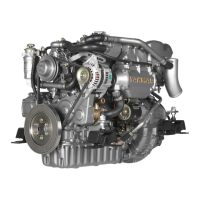
Do you have a question about the Yanmar 4JH3-TE Series and is the answer not in the manual?
| Engine Type | 4-stroke, water-cooled diesel |
|---|---|
| Number of Cylinders | 4 |
| Aspiration | Turbocharged |
| Fuel System | Direct Injection |
| Cooling System | Freshwater cooling with heat exchanger |
| Fuel Type | Diesel |
| Bore x Stroke | 84 mm x 90 mm |
| Rated Output | 56 kW (75 hp) at 3300 rpm |
| Lubrication System | Forced lubrication |
| Starting System | Electric starter |
| Max Power Output | 56 kW (75 hp) |
Explains the meaning of hazard symbols like Danger, Warning, and Caution used in the manual.
Provides essential safety rules for operating and inspecting the engine to prevent injury and ensure safe use.
Details the location and purpose of warning labels affixed to the engine for operational safety.
Describes the engine's application in pleasure boats and its basic driving system configuration.
Provides detailed technical specifications, including power output, dimensions, and gear ratios for various models.
Identifies and labels the major components of the engine with diagrams.
Lists key maintenance parts and explains their respective functions and locations.
Explains the instrument panel, meters, and alarm indicators for engine monitoring.
Details the function and operation of the engine speed and clutch control handle.
Describes the mechanism used for safely stopping the engine operation.
Details the correct selection, handling, and replenishment of engine fluids for optimal performance.
Outlines the crucial steps and checks required before operating the engine for the first time.
Provides step-by-step instructions for starting the engine, including cold weather considerations.
Covers engine acceleration, deceleration, and clutch engagement for forward and reverse movement.
Highlights critical operational checks and potential issues to monitor during engine use.
Details the correct procedure for safely shutting down the engine after operation.
Presents a visual flowchart summarizing the entire engine operation sequence.
Guides on preparing the engine for extended periods of non-use, including fluid draining.
Sets forth fundamental principles for conducting periodic inspections and safety checks on the engine.
Provides a summary of maintenance tasks categorized by inspection intervals and service types.
Details specific inspection and replacement procedures required at different service intervals.
Lists common engine problems, their probable causes, and recommended measures for resolution.
Offers instructions for temporary clutch repairs to enable returning the boat to port safely.
